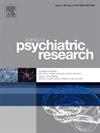精神分裂症患者的社会功能和额叶α不对称。
IF 3.7
2区 医学
Q1 PSYCHIATRY
引用次数: 0
摘要
背景:精神分裂症(SZ)是一种精神障碍,通常涉及社会功能下降。额叶α不对称(FAA)是一种从脑电图(EEG)数据中提取的神经生理标志物,可能与动机和情绪倾向有关,例如各种精神疾病(包括SZ)的动机降低。因此,它可能为社会功能提供一种神经生理学标记。目的:本研究旨在探讨精神分裂症患者的FAA是否与社会功能有关。此外,一组患有自闭症谱系障碍(ASD)的人被纳入研究,以探索这些发现是精神分裂症所独有的,还是在另一个具有非典型社会行为的诊断组中发现的。方法:采用方差分析和回归模型对静息状态脑电图、临床访谈和自我报告测量数据进行评估。研究人员将33名SZ患者的数据与38名健康对照组和30名ASD患者的数据进行了比较。结果:尽管与健康对照组相比,SZ患者的FAA存在差异,但神经生理学的改变与SZ患者社交功能的降低无关。然而,在没有精神病诊断的人群中,FAA与社会功能有关。此外,SZ组和ASD组之间的比较显示,在FAA模式和社会功能方面几乎没有差异,这表明这些领域的疾病之间存在共性。结论:FAA可能不是精神分裂症患者社会功能下降的神经生理学标志,尽管未来的工作应该研究其在精神分裂症和ASD之间其他可能的临床表现中的作用。本文章由计算机程序翻译,如有差异,请以英文原文为准。
Social functioning and frontal alpha asymmetry in schizophrenia
Background
Schizophrenia (SZ) is a psychiatric disorder that often involves reduced social functioning. Frontal alpha asymmetry (FAA) is a neurophysiological marker extracted from electroencephalogram (EEG) data that is likely related to motivational and emotional tendencies, such as reduced motivation across various psychiatric disorders, including SZ. Therefore, it may offer a neurophysiological marker for social functioning.
Objectives
The present study aimed to examine whether FAA is related to social functioning in schizophrenia. Additionally, a group of people with autism spectrum disorder (ASD) was included to explore whether findings are unique to schizophrenia, or whether they are found in another diagnostic group with atypical social behaviors.
Methods
Analysis of variance and regression models were used to evaluate data from resting-state EEG, clinical interviews, and self-report measures. Data from 33 participants with SZ were compared to 38 healthy controls and 30 individuals with ASD.
Results
Although people with SZ showed differences in FAA compared to healthy controls, the altered neurophysiology was not related to reduced social functioning in SZ. However, FAA was related to social functioning in people without a psychiatric diagnosis. Additionally, comparisons between the SZ and ASD group revealed few differences in patterns of FAA and social functioning, suggesting commonalities between the disorders in these areas.
Conclusions
FAA likely does not present a neurophysiological marker for reduced social functioning in schizophrenia, though future work should examine its role in other possible clinical manifestations shared between schizophrenia and ASD.
求助全文
通过发布文献求助,成功后即可免费获取论文全文。
去求助
来源期刊

Journal of psychiatric research
医学-精神病学
CiteScore
7.30
自引率
2.10%
发文量
622
审稿时长
130 days
期刊介绍:
Founded in 1961 to report on the latest work in psychiatry and cognate disciplines, the Journal of Psychiatric Research is dedicated to innovative and timely studies of four important areas of research:
(1) clinical studies of all disciplines relating to psychiatric illness, as well as normal human behaviour, including biochemical, physiological, genetic, environmental, social, psychological and epidemiological factors;
(2) basic studies pertaining to psychiatry in such fields as neuropsychopharmacology, neuroendocrinology, electrophysiology, genetics, experimental psychology and epidemiology;
(3) the growing application of clinical laboratory techniques in psychiatry, including imagery and spectroscopy of the brain, molecular biology and computer sciences;
 求助内容:
求助内容: 应助结果提醒方式:
应助结果提醒方式:


